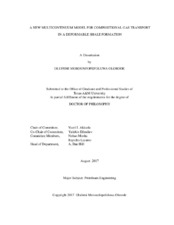| dc.contributor.advisor | Akkutlu, Yucel I | |
| dc.contributor.advisor | Efendiev, Yalchin | |
| dc.creator | Olorode, Olufemi Morounfopefoluwa | |
| dc.date.accessioned | 2018-02-05T21:13:09Z | |
| dc.date.available | 2018-02-05T21:13:09Z | |
| dc.date.created | 2017-08 | |
| dc.date.issued | 2017-07-20 | |
| dc.date.submitted | August 2017 | |
| dc.identifier.uri | https://hdl.handle.net/1969.1/165828 | |
| dc.description.abstract | A new multi-continuum compositional gas simulation model is presented for deformable organic-rich source rocks. The model describes the advective and diffusive mass balance equations for each hydrocarbon components in the organic and inorganic continua. It accounts for the presence of dispersed kerogen with sorbed-gas corrected dynamic porosity. Maxwell-Stefan theory is used to predict the pressure- and composition-dependence of molecular diffusion. The coupled nonlinear system of equations for the multi-component gas transport and geomechanics are discretized using the control volume finite element method, and linearized using the Newton-Raphson iteration scheme. Any fractures in the reservoir domain is modeled using the discrete fracture model.
The simulation is based on a new multi-scale conceptual flow model, in which the kerogen is considered to be discontinuous and dispersed in the inorganic matrix at reservoir simulation scale. Scanning Electron Microscopy images, as well as the expected slow transport in the nanoporous organic matrix in comparison to the advective transport in the organic matrix form the basis for this new numerical model. A simple mass balance equation is introduced to enable kerogen to transfer reservoir fluids to the inorganic matrix that is collocated in the same grid-block. The advective-diffusive transport takes place between neighboring grid blocks only in the inorganic matrix.
The simulation results indicate that the multi-scale nature of the rock is important and should not be ignored because this could result in an overestimation of the contribution of kerogen to production. Although the adsorbed fluid can contribute significantly to storage in these source rocks, its contribution to production could be severely limited by the lack of kerogen continuity at the reservoir scale and by a low degree of coupling between the organic and inorganic pores. The contribution of Maxwell-Stefan diffusion to the overall transport in organic-rich source rocks appears to be more significant at lower values of matrix permeability, and as the permeability decreases in response to pressure decline during production. The coupled geomechanics and flow simulation results indicate that production of reservoir fluids can induce higher compressive stresses that can in turn reduce fracture conductivity, and lead to faster production decline. | en |
| dc.format.mimetype | application/pdf | |
| dc.language.iso | en | |
| dc.subject | Multi-continuum | en |
| dc.subject | compositional | en |
| dc.subject | shale | en |
| dc.subject | Maxwell-Stefan diffusion | en |
| dc.subject | transient coupling | en |
| dc.subject | Control Volume Finite Element | en |
| dc.subject | Unstructured Mesh | en |
| dc.subject | Hydaulic Fractures | en |
| dc.subject | Discrete Fracture Model | en |
| dc.subject | Coupled Geomechanics and Flow Simulation | en |
| dc.subject | CO2 sequestration | en |
| dc.title | A New Multicontinuum Model for Compositional Gas Transport in a Deformable Shale Formation | en |
| dc.type | Thesis | en |
| thesis.degree.department | Petroleum Engineering | en |
| thesis.degree.discipline | Petroleum Engineering | en |
| thesis.degree.grantor | Texas A & M University | en |
| thesis.degree.name | Doctor of Philosophy | en |
| thesis.degree.level | Doctoral | en |
| dc.contributor.committeeMember | Morita, Nobuo | |
| dc.contributor.committeeMember | Lazarov, Raytcho | |
| dc.type.material | text | en |
| dc.date.updated | 2018-02-05T21:13:09Z | |
| local.etdauthor.orcid | 0000-0002-7783-1406 | |


